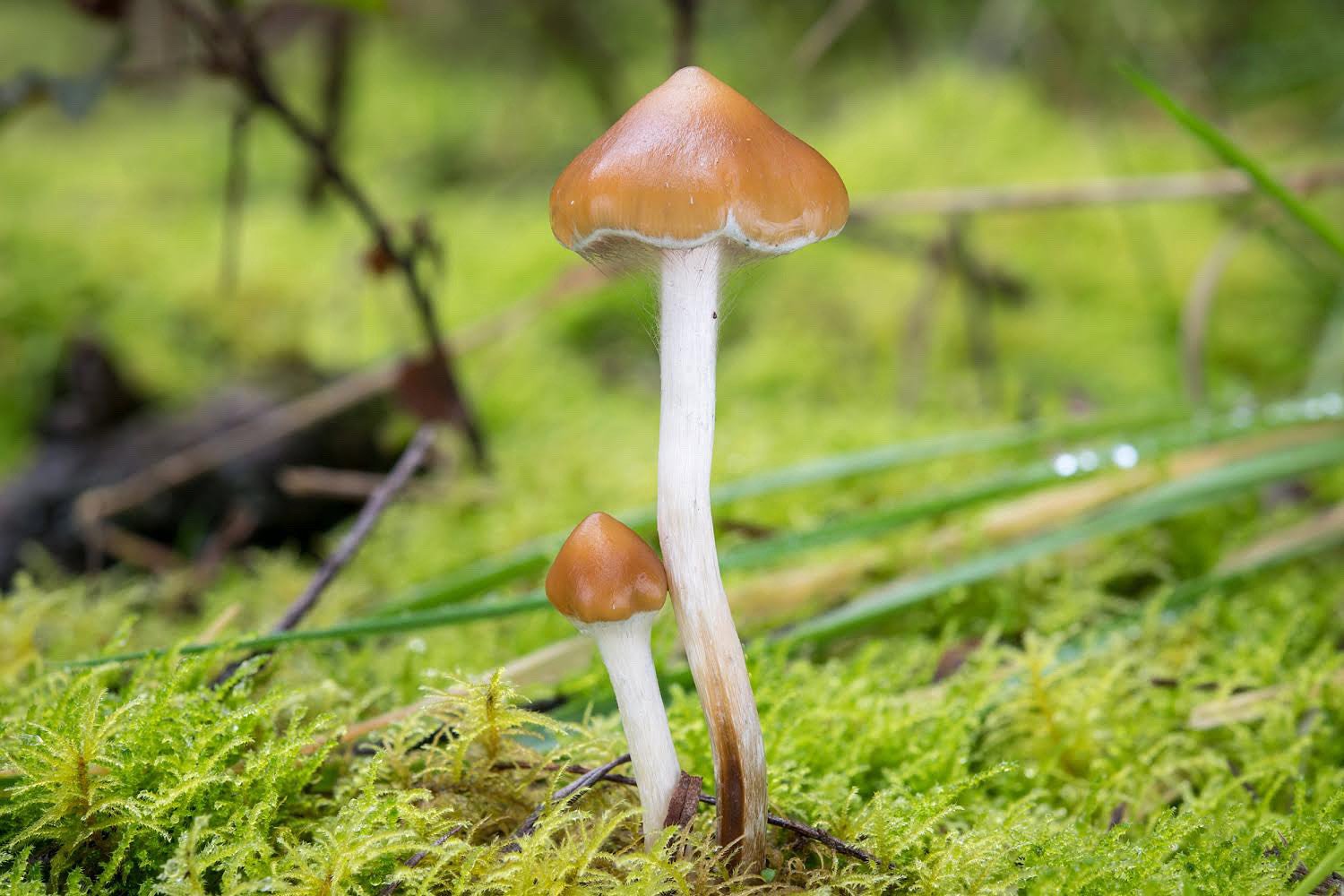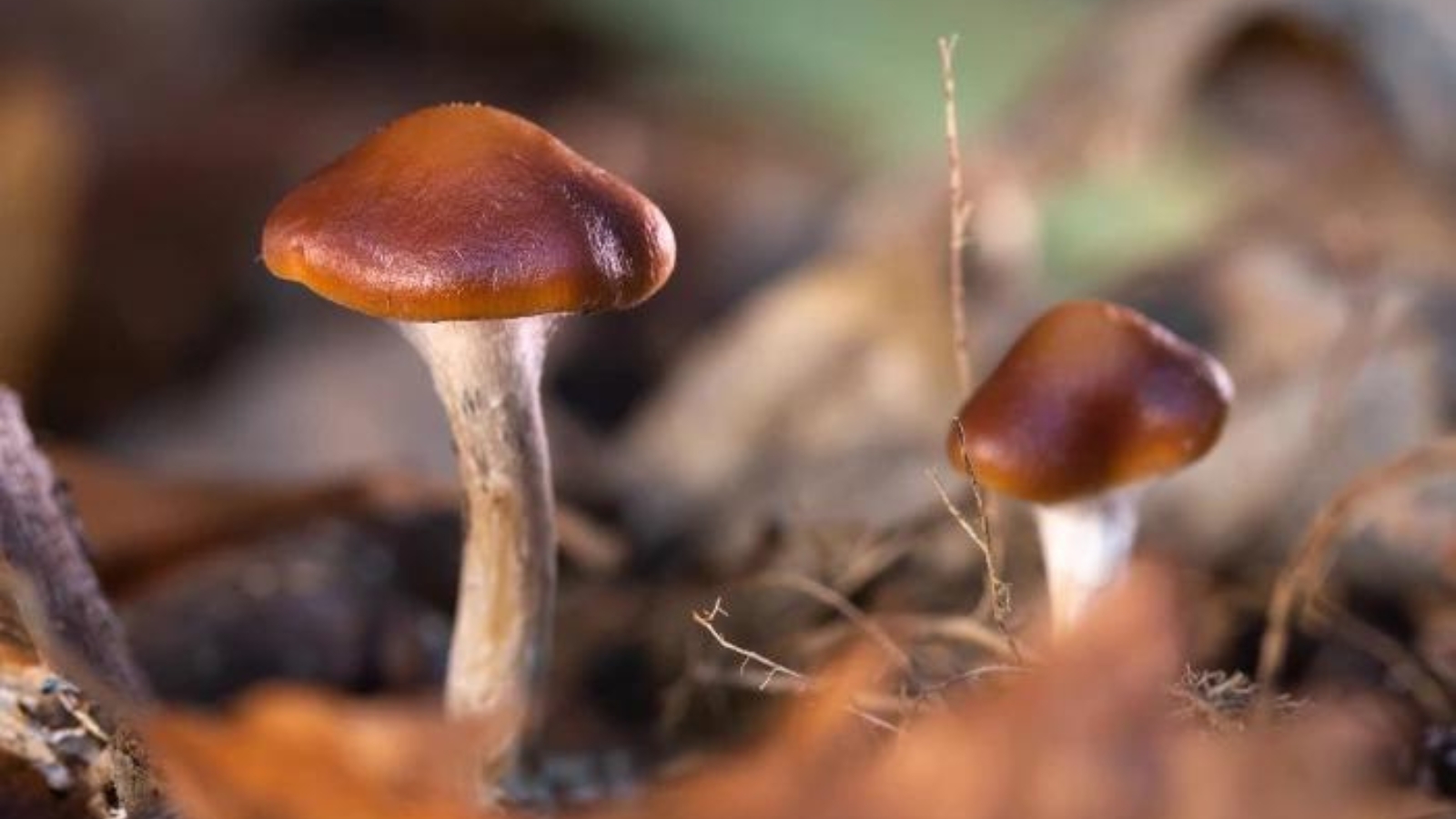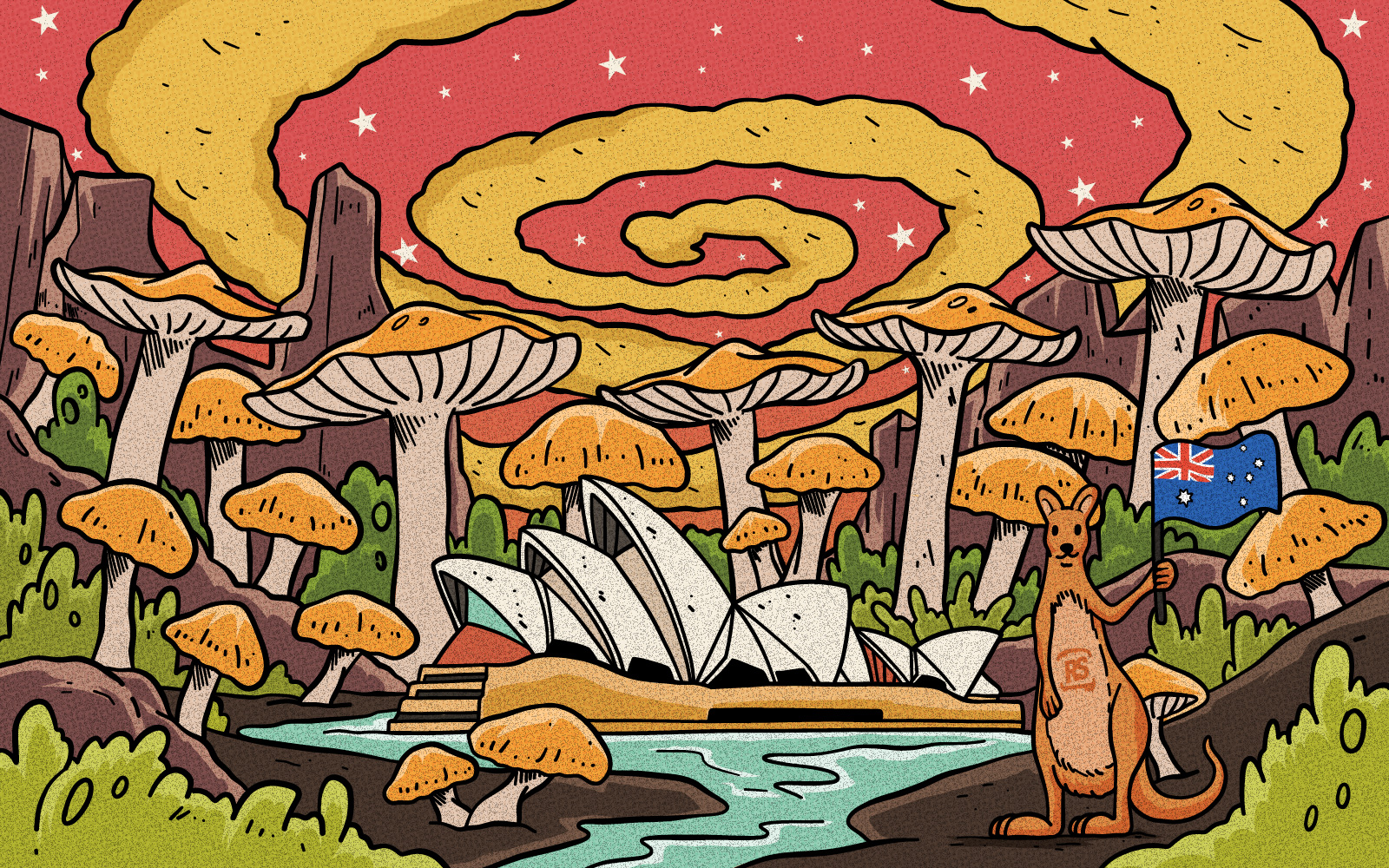The world of fungi, with its mystique and hidden wonders, is one that never ceases to amaze. For the psychedelic enthusiast, the mention of magic mushrooms may evoke images of the golden tops of Psilocybe cubensis. But deep within Australia’s lands, another species in terms of potency reigns supreme: Psilocybe subaeruginosa. The sheer magic of this native mushroom is worth exploring for those who seek a deeper understanding of the world of psychedelics.
The Enigmatic Psilocybe Subaeruginosa
Psilocybe subaeruginosa, often revered in mycological circles, remains an emblematic representation of Australia’s untamed and diverse fungal kingdom. Its very name, “subaeruginosa,” derived from Latin roots, hints at its slightly bluish hue (“sub-aeruginosus” meaning almost bluish). This bluish reaction, common in psychoactive mushrooms, is a result of the oxidation of psilocin, a key psychedelic compound.
However, it’s pronounced potency distinguishes P. Subaeruginosa from other magic mushrooms. Within its tissue lies a powerful cocktail of psychoactive compounds, mainly psilocybin and psilocin. These compounds, when consumed, metabolize and bind to the brain’s serotonin receptors, leading to altered perceptions, heightened sensory experiences, and a sense of connectedness with the environment.
The significance of P. Subaeruginosa extends beyond its psychoactive attributes. For indigenous communities and early settlers of Australia, this mushroom, like others in its genus, might have held ceremonial or spiritual importance, although much of this history remains undocumented or veiled in mystery.
Modern interest in P. Subaeruginosa isn’t solely rooted in its recreational or spiritual use. Researchers and psychonauts alike are exploring its potential therapeutic applications, especially in the realms of mental health. Preliminary studies and anecdotal evidence suggest that compounds in such mushrooms might assist in treating conditions like depression, anxiety, and PTSD.
Additionally, for the curious mycologist, the species presents a challenge and intrigue. Its preferred habitats, fruiting behavior, and resilience make it a captivating subject of study.
Thriving Habitat and Growth Conditions
Psilocybe subaeruginosa is not just another mushroom found in the vast landscapes of Australia; it’s a species that has carved a niche for itself, thriving in specific ecological zones. Understanding its habitat preferences and growth conditions offers a fascinating glimpse into its world.
Preferred Habitats of Psilocybe Subaeruginosa
Like many members of the Psilocybe genus, P. Subaeruginosa has a penchant for woody environments. This mushroom isn’t the type to appear in open grassy fields. Instead, it favors the decaying remnants of the arboreal world. Wood chips, decaying logs, and the rich, organic mix found in forest litter are its preferred substrates. The presence of eucalyptus debris, in particular, seems to be a beacon for this species, possibly due to the specific microbial ecology associated with eucalyptus decomposition.
Climatic Conditions for Optimal Growth
Mushrooms are often synonymous with damp, cool environments, and P. Subaeruginosa is no exception. While it can tolerate a range of climatic conditions, it truly flourishes in cooler temperatures, particularly those ranging between 10°C to 20°C (50°F to 68°F). Humidity also plays a crucial role in its life cycle. Areas with consistent moisture from frequent rainfall or morning dew are often hotspots for P. Subaeruginosa.
However, it’s not a fan of waterlogged or stagnant conditions. The balance of moisture is crucial: enough to maintain humidity but not so much that it drowns the mycelium or promotes the growth of competing molds.
Seasonal Fruiting Patterns
Aligning with its climatic preferences, P. Subaeruginosa predominantly fruits in the cooler months. While this can vary based on specific regional climates in Australia, winter emerges as the prime season. After a generous bout of rain, as the moisture seeps into the woody substrate and temperatures remain cool, these mushrooms emerge in full glory. The fruiting can be so prolific in ideal conditions that it seems as if the forest floor or mulch beds are speckled with gold, or in this case, the caramel hues of P. Subaeruginosa.

Identifying Psilocybe Subaeruginosa
Within the myriad world of mushrooms, each species wears its unique identity. While the Psilocybe subaeruginosa does stand out among its peers, it’s essential to be meticulous during identification. After all, the forest is a repository of both wonders and warnings.
Visual Characteristics and Variability
At first glance, the cap of P. Subaeruginosa might seem like a simple, convex structure. But as the mushroom matures, this convexity flattens out, occasionally revealing a slight central umbo. The color can be captivating – from deep caramel and tan in younger specimens to a paler shade in mature ones, especially when drying.
Underneath the cap, the gills offer another visual cue. They’re typically a deep purplish-brown, becoming darker with age, especially as the spores mature. When handled, the slender and long stem can sometimes showcase bluish bruises – a classic indication of psilocin oxidation.
However, it’s worth noting that P. Subaeruginosa can display variability based on factors like age, environment, and substrate. This means that while the general characteristics remain consistent, there can be subtle differences between individual specimens.
Distinctive Features for Identification
One of the telltale signs of P. Subaeruginosa is the gelatinous pellicle – a thin, separable layer – that sheaths the cap. When touched or prodded, this pellicle can often give the cap a slightly sticky sensation. Furthermore, the bluish bruising, especially prominent when the stem is pinched or damaged, indicates its psychoactive nature. Though, caution: bluing isn’t exclusive to psychedelic mushrooms.
Avoiding Confusion with Look-alike Species
Nature, in all its wisdom, often presents challenges. In the realm of mycology, this challenge comes in the form of look-alike species. While P. Subaeruginosa is distinctive, a few species bear a deceptive resemblance.
Galerina, Cortinarius, and Hypholoma: Similarities and Risks
The Galerina species, especially Galerina marginata, can be a deadly doppelganger. It bears a striking resemblance in size and color but contains potent toxins that can be fatal.
Cortinarius species can be mistaken for P. Subaeruginosa with their rusty brown spore print. While not all are deadly, some contain harmful toxins that can lead to kidney damage.
Hypholoma species, though less toxic than Galerina or Cortinarius, can still cause gastrointestinal distress. Their bitter taste, if ever sampled, is a stark difference from the neutral taste of P. Subaeruginosa.
Cultivating Psilocybe Subaeruginosa
The cultivation of mushrooms, whether for culinary, medicinal, or experimental purposes, has long fascinated humans. When it comes to Psilocybe subaeruginosa, the intrigue deepens, given its potency and cultural significance. But cultivating this particular species is not just about understanding its biological needs; it’s also about navigating the legal and ethical landscape.
Legal Considerations and Decriminalization
Before diving into the world of mycological cultivation, it’s crucial to understand the legal framework. In many parts of the world, including Australia, the cultivation, possession, and distribution of psychoactive mushrooms, including P. Subaeruginosa, are illegal. The penalties can range from fines to imprisonment, depending on the scale of cultivation and intent of use.
However, there’s a silver lining. Over the past few years, there’s been a shift in the perception of psychedelic substances. Decriminalization movements have gained momentum in various regions, advocating for the medicinal and therapeutic potential of these substances. While this doesn’t equate to legalization, it does reduce the legal consequences associated with possession or cultivation for personal use. Still, it’s imperative for aspiring cultivators to familiarize themselves with local regulations.
Suitable Substrates for Cultivation
P. Subaeruginosa thrives in specific conditions in the wild, and replicating this environment is key to successful cultivation. Given its love for woody substrates, a mixture of hardwood chips (especially eucalyptus) and organic matter proves ideal. Adding some straw can enhance the substrate’s texture, facilitating better mycelial growth.
It’s also essential to maintain the right balance of moisture. The substrate should feel damp, like a wrung-out sponge, but not waterlogged. To minimize contamination risks, a good practice is to pasteurize or sterilize the substrate before introducing the P. Subaeruginosa spores or mycelium.
Insights From Paul Stamets’ Techniques
Paul Stamets, a revered figure in the world of mycology, has pioneered numerous techniques for cultivating various mushrooms. For Psilocybe species, his “PF Tek” method, originally designed for Psilocybe cubensis, can be adapted for P. subaeruginosa. This technique involves using brown rice flour and vermiculite as a substrate, packed in small jars. Once colonized by the mycelium, these cakes can then be birthed and introduced to fruiting conditions.
Another insight from Stamets is the importance of patience and observation. Cultivating mushrooms isn’t just about following steps but understanding the subtle cues the mycelium and mushrooms provide. Factors like light, fresh air exchange, and humidity play critical roles in the fruiting process.

Potency and Microdosing
The realm of psychedelic mushrooms is diverse, with each species offering a unique blend of compounds, effects, and experiences. Psilocybe subaeruginosa stands out prominently in this domain, often dubbed one of the most potent magic mushrooms. However, with this potency comes the need for understanding, respect, and safe practices, especially in the burgeoning world of microdosing.
Understanding the Strength of Psilocybe Subaeruginosa
Within the tissue of P. Subaeruginosa lies a potent mix of psychoactive compounds, primarily psilocybin and psilocin. Compared to more well-known species like Psilocybe cubensis, P. subaeruginosa typically possesses a higher concentration of these molecules, accounting for its pronounced effects even in smaller quantities. This strength, while making it a favorite among some psychonauts, also demands a heightened awareness and caution for those unfamiliar with its effects.
Safety Measures for Consumption
Given its potency, there are several guidelines one should adhere to when considering consumption:
- Dosage: Start with a low dose, especially if you’re unfamiliar with the effects of P. subaeruginosa. It’s easier to incrementally increase the dose in subsequent sessions than to navigate an unexpectedly intense experience.
- Set and Setting: Ensure you’re in a safe, comfortable environment, ideally with a trusted and sober individual, particularly if it’s your first experience or if you’re consuming a higher dose. Consider your mental and emotional state before consumption. Psychedelics amplify underlying emotions, so it’s essential to be in a relatively stable state of mind.
- Purity: Be absolutely certain of the mushroom’s identification. As discussed earlier, there are look-alikes that can be harmful or even fatal.
- Interactions: Be wary of combining the mushroom with other substances, including alcohol or prescription medications, as these can lead to unpredictable effects.
Remember the age-old adage of psychedelics: you can always take more, but you can’t take less!
Microdosing as a Trend
Microdosing, the practice of consuming sub-perceptual doses of psychedelics, has seen a meteoric rise in popularity over recent years. Advocates argue it boosts creativity, elevates mood, and enhances cognitive function without inducing a full-blown psychedelic trip.
When microdosing P. Subaeruginosa, its high potency means even smaller quantities are necessary compared to other species. Generally, a microdose ranges from 0.1g to 0.2g of dried mushroom, but given the strength of P. Subaeruginosa’, starting at the lower end or even less is advisable.
The practice has gained traction among various professionals, from Silicon Valley entrepreneurs to artists, many of whom vouch for its subtle yet transformative effects. However, it’s worth noting that while anecdotal evidence abounds, scientific research on microdosing and its long-term effects is still in its infancy.
Wood Lover Paralysis: Myth or Reality?
Mycology and the world of psychedelic mushrooms are rich tapestries of lore, legend, and deeply scientific truths. One of the more curious tales that echo through the mushroom community concerns the so-called “Wood Lover Paralysis,” specifically associated with certain psilocybin-containing mushrooms. This phenomenon has become a point of intrigue, caution, and ongoing research. But is it a mere myth, or is there a tangible reality behind these accounts?
Exploring the Phenomenon of Wood Lover Paralysis
Wood Lover Paralysis (WLP) refers to temporary paralysis or significant muscle weakness experienced after consuming certain species of “wood-loving” psychedelic mushrooms. These symptoms can manifest as difficulty in moving limbs, facial drooping, and, in severe cases, an inability to stand or walk. The onset can be rapid or delayed, and the duration varies, though it usually subsides within a day.
While Psilocybe subaeruginosa is often cited in connection with WLP, other species like Psilocybe cyanescens and Psilocybe azurescens have also been linked to similar experiences. The strange aspect of WLP is its inconsistency. Not everyone who consumes these species experiences paralysis, and those who do don’t always face it with every consumption.
Survey Findings and Environmental Factors
While anecdotal reports of WLP abound in psychedelic communities, concrete scientific data has been somewhat elusive. However, informal surveys within the community suggest a correlation between the occurrence of WLP and specific environmental conditions during the mushroom’s growth. There are suggestions that mushrooms growing in colder climates or those exposed to early frosts might have a higher propensity to induce WLP.
Further complicating the picture is the fact that WLP isn’t strictly dose-dependent. Some individuals have reported symptoms after consuming relatively small amounts, while others have remained unaffected even after ingesting larger quantities.
Ongoing Research and Theories
The cause of WLP remains one of the great mysteries in the realm of mycology. One leading theory posits that WLP isn’t directly related to psilocybin or psilocin but might be caused by another unidentified compound present in these mushrooms. This compound may be produced or become more prevalent under specific environmental conditions, explaining the variability in WLP occurrences.
Another theory suggests a possible interaction between these mushrooms and other substances or medications that an individual might have consumed, leading to these adverse effects. This theory, however, doesn’t fully explain instances where WLP has occurred in individuals who consumed only the mushroom and no other substances.















